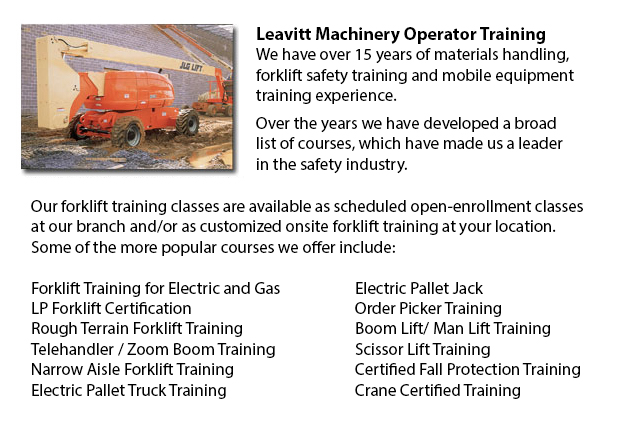
Manlift Training Prince Albert - Different manlift training programs include the review and content of manlift devices. An essential part of the program is the practicum where students demonstrate their knowledge and practical ability to operate the manlift safely. A requirement to Manlift training is the fall protection training, that can be included in the training according to the particular requirements of the customer.
Course Content
The program content includes: the impact of doing unsafe acts or utilizing unsafe machinery, pre-shift equipment inspection and work area survey requirements, Review of load capacities, Lifting devise machine definitions, the specific machine requirements and safety decals, Review of related sections of the OSHA Standards as well as the CSA Standards and Review site particular Dangers, along with controls for safely using a lifting device.
Demonstration and Evaluation Content
The demonstration and evaluation part of the program consists of: Proper personal protective equipment or also known as P.P.E. as needed; Using a signaler or a spotter when required; Utilizing the proper fitting harness or fall arrest devise; Using a lift only on solid and level ground; Using the lift with all other staff clear of the job location; Aware of load limits etc. and other specs as set out by the manufacturer; Pre-shift work area survey and equipment inspection; Having all associated machinery safely stored on the lift platform; Ensuring a smooth and safe operating speed for different plant conditions and isolating off the work area when major work projects are to be finished.
Every individual would be tested to make certain they can efficiently and safely utilize your site-specific machinery.
Manlift Safety
Since the manlift is capable of lifting personnel and materials over 20 feet in the air, these machinery pose a particular amount of risk and could be dangerous machines if not utilized correctly. Because the danger is so apparent, lift owners and operators are careful to properly maintain their equipment and follow right operating procedures and safety measures. The ratio of accidents involving this particular machinery is fairly low.
The safety specifications for scissor lifts and boom lifts puts the burden for safe manlift operation on the user. You are responsible for understanding how to safely use the lift even if you only lease the equipment for one day. The most basic safety features on the equipment are safety decals and the operating handbook. These show essential information regarding the operating procedures, safety machinery and maintenance.
Newer lift models would come together with manuals and decals in place. Technically, the operating manual must be kept on the lift itself. If you are buying a second-hand lift, it is important to ensure that the handbook is included and that essential decals haven't been painted over. The restraints that prevent operators from falling and the guardrails are other important safety features. These are mandatory and standard on all types of lifts.
-
Zoom Boom Training Prince Albert
Zoom Boom Training Prince Albert - Zoom Boom Training focuses on correctly training potential operators on variable reach forklifts. The training objectives include gaining the understanding of the machine's physics and to be able to define the job o... More -
Bucket Truck Training Prince Albert
Bucket Truck Training Prince Albert - The Vehicle-Mounted Aerial Work Platform or also called bucket truck training program is intended to reduce the chance of incident and personal injury when working with or in close proximity to bucket trucks by e... More -
Aerial Lift Training Prince Albert
Aerial Lift Training Prince Albert - An aerial work platform is a mechanized access platform. This device provides access to otherwise not accessible places for people or equipment. Likewise called an aerial device or elevating work platform, the mac... More -
Overhead Crane Ticket Prince Albert
Overhead Crane Ticket Prince Albert - The overhead crane is a common heavy machinery utilized in industrial settings. This particular machine is known as a bridge crane and comprises parallel runways spanned by a traveling bridge. The hoist is the co... More -
Scissor Lift Ticket Prince Albert
Scissor Lift Ticket Prince Albert - Scissor lifts have greatly benefited construction operations because the task that used to need a lot of effort and lots of people, can now be accomplished using the scissor lift and just one individual, the operat... More -
Skid Steer Loader Training in Prince Albert
The engine powered skid-steer loader consists of a rigid and small frame, equipped along with lift arms which could attach to various industrial attachments and tools to be able to perform various labor saving tasks. Normally, skid-steer loaders are... More -
Crane Training School Prince Albert
Crane Training School Prince Albert - We provide industry relevant programs in our crane training school. The course will provide our trainees with learning outcomes matching the existing industry demands. Our small class sizes combine theory and han... More -
Overhead Crane Operator Training Prince Albert
Overhead Crane Operator Training Prince Albert - Our overhead crane operator training program is meant to teach workers the basics of overhead crane/sling operation and pre-shift inspections. Courses are taught by our professional trainers and consul... More

Forklift Training Prince Albert
TOLL FREE: 1-888-254-6157
Prince Albert, Saskatchewan
forklifttrainingprincealbert.com
Email Us
About Us


